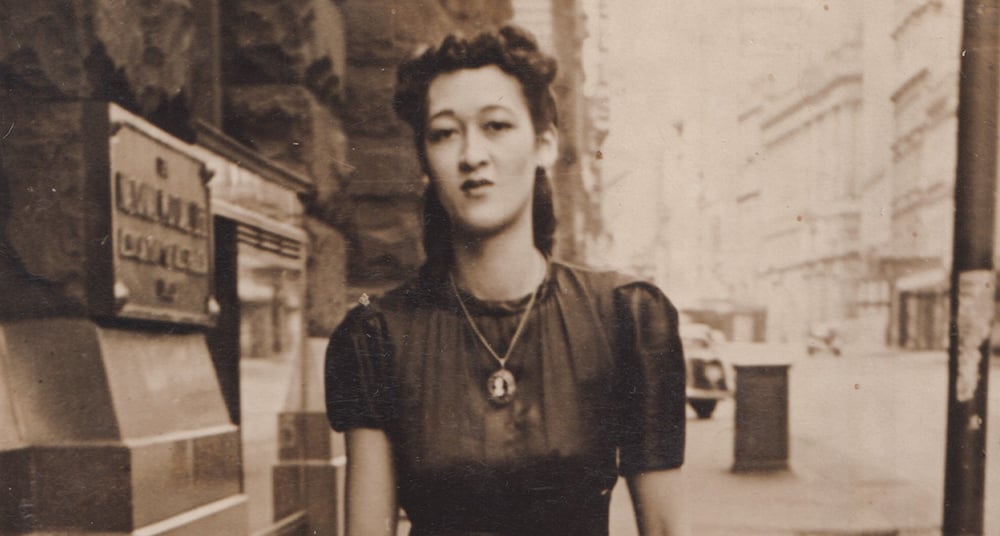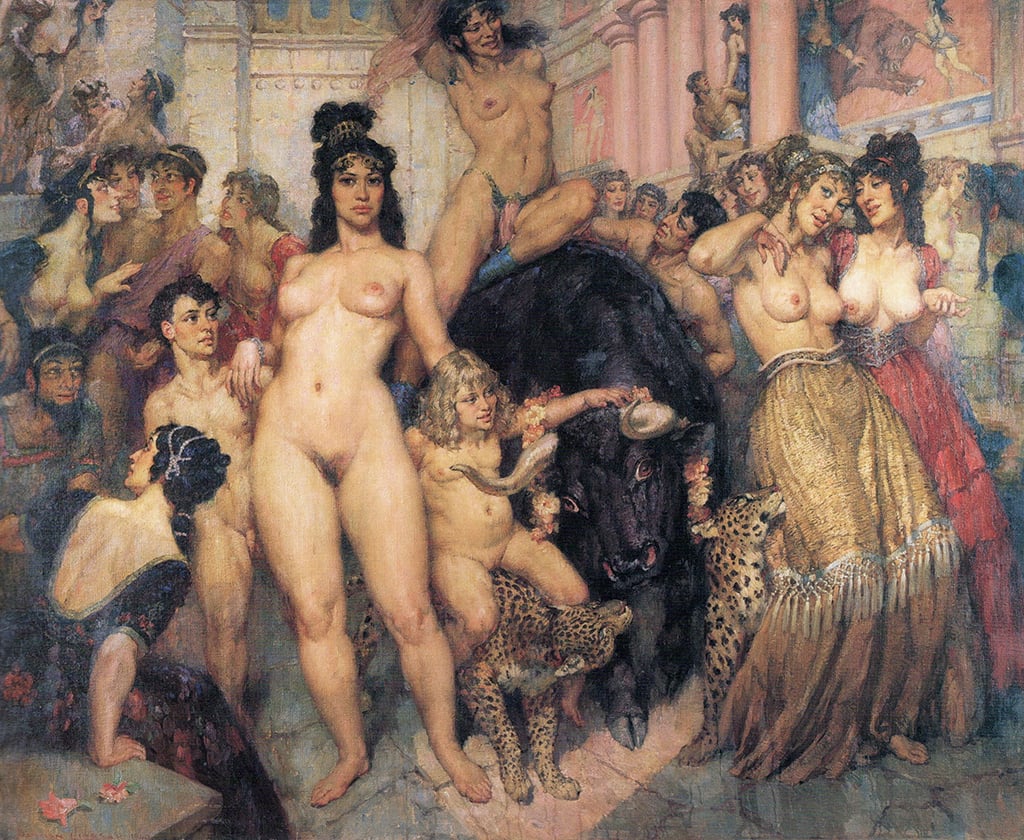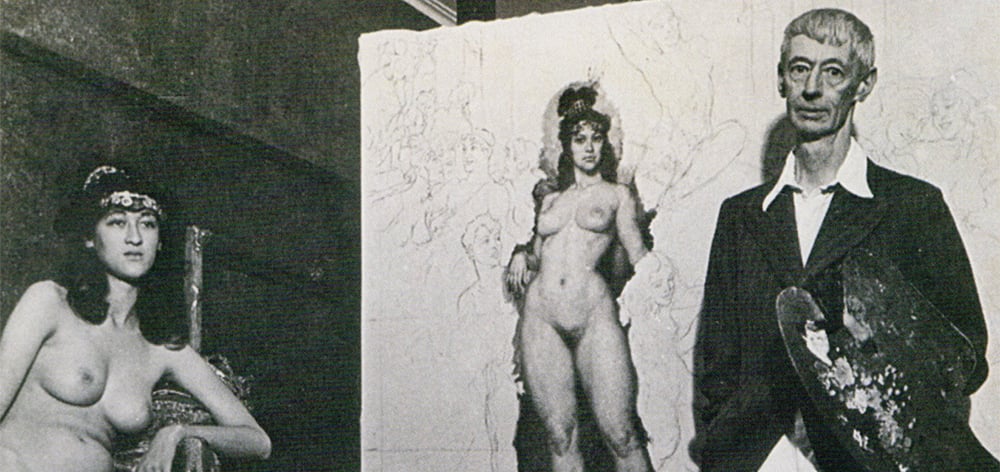Starting out as a factory worker, Rita Lee took up modelling to support her family and went on to inspire some of Norman Lindsay’s most famous artworks.
One of the first things you see when walking into Norman Lindsay Gallery is a large oil painting called Two Models. Seated calmly in the background, in a green drape, is the woman who would become Norman Lindsay’s most famous model.
Her name was Rita Lee; a striking Chinese Australian who began posing in her late teens. Two Models was the first Lindsay painting that Rita sat for, and she was to become the central figure in many of the paintings in Lindsay’s highly productive period of the 1930s and 40s.
Lindsay said of Rita: “she was a gift from the gods, a model such as happens once in a blue moon.” Her combination of detachment, elegance and striking good looks made Rita the perfect model.
An entrance into the art world
Rita Young (nee Lee) was born in Sydney’s Annandale in 1920. Her mother was Anglo-Australian, and her father Chinese. It is believed that her maternal great-grandparents were Spanish Moroccan.
Coming of age during the Great Depression, Rita and her three siblings often went hungry. By the time she was 14, Rita had left school and was working to help support her family with jobs at biscuit and cosmetics factories.
In 1937, at the age of 17, Rita met the artist Joe Holloway and began posing for him at the Sketch Club in Haymarket. Joe introduced Rita to Lindsay while Lindsay was working at 12 Bridge Street, Sydney. When Lindsay moved back to the Blue Mountains to his home, Springwood, in 1940, Rita traveled there to pose for him.

A new medium
At this time, Lindsay was experimenting with oil painting. He had already mastered drawing, etching and watercolours, but now in his early fifties he was grappling with the demands of an unfamiliar medium and the challenges of painting realistic flesh tones.
Rita was a revelation for Lindsay, whom he described as “the perfect model for the métier of oil painting. (She was) a quiet reticent girl, who seldom spoke, who secreted within her all those emotional intensities from which any variation on the feminine image may be extracted.”
During the late 1930s and early 1940s, Lindsay painted many oils of Rita. She is the central figure in a major work Crete (1940). Painted during one of her visits to Springwood even her younger brother was enlisted to pose for the figure to her right.

Lindsay’s daughter, Jane, said Rita was the perfect house guest: “Serenity was her outstanding attribute…she talked very little and almost in a whisper…hardly making her presence known – graceful and quiet. She managed to make a kitchen chair look like a throne.”
Rita’s daughter, Marguerite Young says that “Norman Lindsay treated my mother with the utmost respect. Rita had a hard upbringing, and in Springwood she was treated very well. She loved that period of her life.”

Portraits and costumes
As well as the large-scale compositions, Lindsay’s smaller portraits of Rita are also considered to be among the best of his oil paintings. In the early 1940s he painted a number of portraits of Rita in costume, such as Rita of the Seventies (1942) and Rita of the Nineties (1942).
Lindsay had a nostalgia for late 19th century fashion and went to great lengths to have the costumes made for this series of paintings. Rita could easily pull off the belle epoque glamour. In fact, when a blonde model cancelled a sitting, Lindsay turned to Rita, who was always punctual and reliable. Rita of the Seventies shows her in a frilled bodice typical of the era, as well as a blonde wig that was specially made for the sitting.
In all of his paintings of Rita, Lindsay captured her quiet, regal bearing. Though mostly silent while working together, Rita and Lindsay did sometimes discuss his work.
In John Hetherington’s book Norman Lindsay – The Embattled Olympian, the author wrote: “(Lindsay and Rita) never talked much, but now and then, in a rest interval, she made some remark which told him a questing mind was at work behind the quiet mask of her face. ‘Art is a sort of religion, isn’t it?’ she said one day. ‘That’s about as good a definition as you’d ever find for it, he agreed.”

A model’s legacy
Rita married the photographer George Young in 1943, after which she posed only occasionally for Lindsay. She and George moved to Melbourne and joined the war effort, working at General Motors Holden, before returning to Sydney.
Rita continued to visit Springwood with her family for many years, and remained friends with Lindsay until his death in 1969. After a long illness, Rita died in July 2000 at the age of 80.
Reflecting on her mother’s legacy, Marguerite says Rita was always proud of the paintings she featured in.
“Lindsay was trying to capture my mother’s beauty,” says Marguerite. “I never saw her pictures as sexual. I see them as a homage to women. My mother and father both brought me up to see beauty in the human body.”

24 years after her death, Rita Lee’s presence in Lindsay’s art can still be seen in the paintings that now hang at Norman Lindsay Gallery, which is cared for by the National Trust (NSW).
Walk into the main gallery with its vibrant red walls, and you can see for yourself the epic Two Models, with Rita Lee serenely looking over the room with a detached and elegant eye.
Norman Lindsay Gallery is open Thursday to Monday from 10am to 4pm. Plan a visit.


 Twitter
Twitter Facebook
Facebook Linkedin
Linkedin Email
Email
Most interesting glimpse into the life of Norman and the people he worked with I discovered Norman half a century ago ,when I emigrated at 23 ,now 88 . Why on earth aNorman Lindsay does not get exposure in the UK? is a mystery beyond me .
My family lived in Lithgow in the early to mid 1950s. Our parents were friends with George and Rita and we saw them often.
All I knew of the relationship was as a child and that George was a photographer and we have some of his photos still now in 2025.
We associated with their children then and knew the family when they moved to the hills of either Epping or environs and we had moved to Fairfield.
My father was a chief librarian and travelled in those circles Lithgow and the mountains seems to have been quite the civilised place back in the 1950s and 60s.
I remember caring for Rita in a.nursing home at Normanhurst, Sydney around 1991.